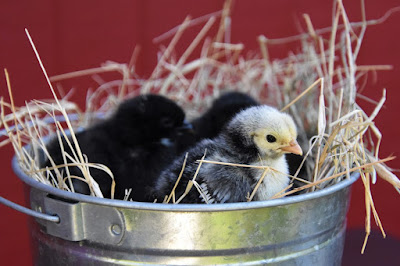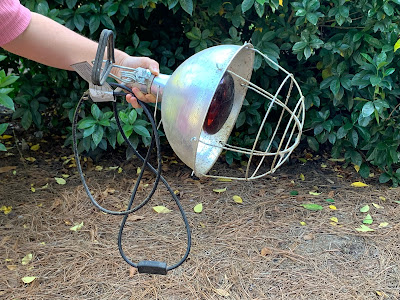What You Need to Know Before Purchasing Baby Poultry
We raised over 150 poultry this past year: ducks, geese, chickens, turkeys, and guineas! It was an amazing experience, and we learned so much! Even though poultry are among the most commonly purchased farm animals, there are many people who take home ducklings, goslings, chicks, poults, and keets who really don't understand what these babies need and why. We want to share with you the information to know and the supplies to purchase so you can raise poultry successfully!
Some of our adorable chicks
Brooder. It is crucial to prepare a safe place to keep your baby poultry warm. You should always have at least two babies--one by itself will not make it. Pick a place that is completely out of the weather and free from prowling predators (including household pets!). For the brooder, there are many different options: wooden crates, plastic totes, livestock water troughs, and cardboard boxes. You just need to use something that has sides high enough so the birds cannot fly out, but does not retain all of the heat and cook them. We like using cardboard boxes--we just throw the whole thing out when it is messy and use a fresh box. On the bottom of the brooder, lay down fine pine shavings to absorb the manure and keep everything dry.
Brooder Setup 1
Brooder Setup 2
Heat Lamp. You want to maintain a steady temperature for the baby poultry. During the first week, a temperature of around 90 degrees F is usually sufficient. However, ducklings and goslings, with their insulating down feathers, will need a slightly cooler temperature as they mature. If you are trying to figure out if the temperature is too hot or too cool, just look at where the baby poultry are. If they are huddled under the lamp, it is too cool (lower the position of the lamp, or use more than one). If they are not going anywhere near the lamp, it is too hot (raise the position of the lamp). If they are comfortably running all over the brooder, the temperature is perfect! Do not place the feed or water directly under the heat lamp. Make sure that the one you purchase comes with a guard over the bulb. Even though many companies have worked to decrease the fire hazard of heat lamps, the guard is an added safety measure to prevent the hot bulb from directly touching something flammable or frying a bird if it were to fall. The heat lamp should be securely clamped to something stable, like a shelf beside the brooder, or carefully hung over the brooder. Use a bulb specifically labeled for a brooder. Heat lamps and bulbs are sold at any livestock supply store.
Heat Lamp with Guard
Waterer. Baby poultry need a special waterer since they are prone to drowning. These ones (pictured) are best. We buy ours from Tractor Supply. When you place the baby poultry in the brooder, dip each of their beaks in the water to show them where it is. For the first week, fill the waterer with warm (not hot) water--this prevents their internal organs from getting chilled. We like to give them a tablespoon and a half of apple cider vinegar per quart of water to boost their immune systems throughout the time they are in the brooder.
Waterers for Baby Poultry
Feed/Feeder. We use Dawson Gap Naturals' livestock feeds for all of our poultry (we run a co-op to bring these feeds to our area, so if you're interested in joining our group, contact us). Chicks need a 21% protein chick starter. Poults (baby turkeys) and keets (baby guineas) need a 26% protein game bird starter. Ducklings and goslings need a 21% protein waterfowl starter (these formulas contain extra niacin, which is necessary for proper growth; if you see them having trouble walking, this is most likely from a niacin deficiency). All of the starters need to have very small pieces for the baby poultry to swallow easily. We like to raise chicks in the same brooder as poults and keets, since chicks have more of an instinct to scratch and peck--poults and keets can be tragically slow to learn. To start the baby poultry off, we will place the feeder (this can be purchased from Tractor Supply) on top of a bright, solid-colored piece of paper, with feed sprinkled all over it to encourage them to peck around and find the feeder.
Feed and Feeders for Baby Poultry
When are the baby poultry ready to move out of the brooder? Once they are fully feathered at about six to eight weeks (no more fuzzy feathers are visible and adult feathers have grown in), they can regulate their own body temperature. At this point, they are ready to be moved outside, if the temperatures are mild. Depending on the type of poultry you are raising and your setup for them, you may want to keep them in a run until they are larger and more mature before allowing them to free range. Ducklings and goslings need to be supervised when they swim until they are fully feathered (about eight weeks old), otherwise they can get chilled or drown.
How long do baby poultry need to be on starter feeds? How long you use starter feeds and what you use after that will depend on what you are raising them for. After about eight weeks, laying chicks will move onto Chicken Grower 18%; then, once they start laying, they will need to be on Chicken Layer 16% (if the feed you give them ever has less than 16% protein, they will stop laying). For our Cornish Cross meat chicks, we like to give them Turkey Starter 26% for the first couple of weeks, then move them onto Chicken Grower 18% until they are butchered (Cornish Cross chicks must have their feed picked up after they are about ten days old, or they will eat themselves to death--we do twelve hours with feed, twelve hours without feed). We feed our turkeys Turkey Starter 26% for about eight weeks, then move them onto Turkey Grower 24%, and, for the last four weeks before butchering, we provide free-choice wheat with grit. Similar to turkey poults, guinea keets are fed a game bird starter 26% for the first eight weeks, then are fed a game bird grower 24% for several weeks, and we transition them onto Chicken Layer 16% after that. For our ducklings and goslings, we give them Duck Starter 21% for the first few weeks, then move them onto Duck Grower 18% until they are butchered. If you are keeping ducks or geese for laying, they will need to be on a layer feed for waterfowl once they are laying eggs.
Do I need to be concerned about internal parasites? Coccidia is the most common internal parasite to cause issues in young poultry. If they have bloody manure, they most likely have coccidia. As a preventive measure, we add GI Soother (a powdered herb blend) to their feed once they are about a week old. If we are ever really struggling with coccidia in our young poultry, as in the case of a very wet year, we put Corid in their water for about a week.
We pray that this helps you in your journey to raise happy, healthy birds! If you have any further questions, feel free to ask us!








Comments
Post a Comment